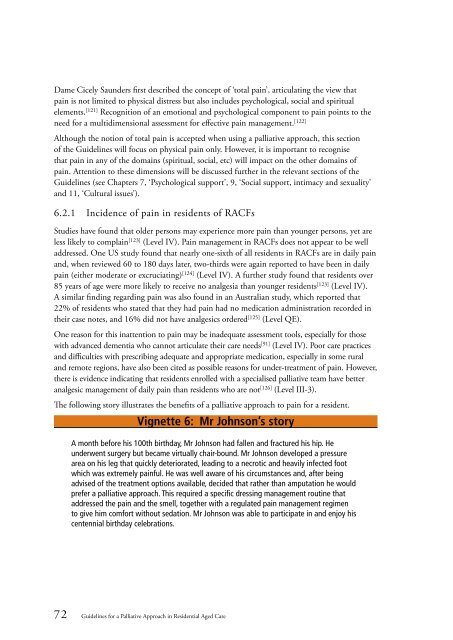Guidelines for a Palliative Approach in Residential Aged Care
Guidelines for a Palliative Approach in Residential Aged Care
Guidelines for a Palliative Approach in Residential Aged Care
Create successful ePaper yourself
Turn your PDF publications into a flip-book with our unique Google optimized e-Paper software.
Dame Cicely Saunders first described the concept of ‘total pa<strong>in</strong>’, articulat<strong>in</strong>g the view that<br />
pa<strong>in</strong> is not limited to physical distress but also <strong>in</strong>cludes psychological, social and spiritual<br />
elements. [121] Recognition of an emotional and psychological component to pa<strong>in</strong> po<strong>in</strong>ts to the<br />
need <strong>for</strong> a multidimensional assessment <strong>for</strong> effective pa<strong>in</strong> management. [122]<br />
Although the notion of total pa<strong>in</strong> is accepted when us<strong>in</strong>g a palliative approach, this section<br />
of the <strong>Guidel<strong>in</strong>es</strong> will focus on physical pa<strong>in</strong> only. However, it is important to recognise<br />
that pa<strong>in</strong> <strong>in</strong> any of the doma<strong>in</strong>s (spiritual, social, etc) will impact on the other doma<strong>in</strong>s of<br />
pa<strong>in</strong>. Attention to these dimensions will be discussed further <strong>in</strong> the relevant sections of the<br />
<strong>Guidel<strong>in</strong>es</strong> (see Chapters 7, ‘Psychological support’, 9, ‘Social support, <strong>in</strong>timacy and sexuality’<br />
and 11, ‘Cultural issues’).<br />
6.2.1 Incidence of pa<strong>in</strong> <strong>in</strong> residents of RACFs<br />
Studies have found that older persons may experience more pa<strong>in</strong> than younger persons, yet are<br />
less likely to compla<strong>in</strong> [123] (Level IV). Pa<strong>in</strong> management <strong>in</strong> RACFs does not appear to be well<br />
addressed. One US study found that nearly one-sixth of all residents <strong>in</strong> RACFs are <strong>in</strong> daily pa<strong>in</strong><br />
and, when reviewed 60 to 180 days later, two-thirds were aga<strong>in</strong> reported to have been <strong>in</strong> daily<br />
pa<strong>in</strong> (either moderate or excruciat<strong>in</strong>g) [124] (Level IV). A further study found that residents over<br />
85 years of age were more likely to receive no analgesia than younger residents [123] (Level IV).<br />
A similar f<strong>in</strong>d<strong>in</strong>g regard<strong>in</strong>g pa<strong>in</strong> was also found <strong>in</strong> an Australian study, which reported that<br />
22% of residents who stated that they had pa<strong>in</strong> had no medication adm<strong>in</strong>istration recorded <strong>in</strong><br />
their case notes, and 16% did not have analgesics ordered [125] (Level QE).<br />
One reason <strong>for</strong> this <strong>in</strong>attention to pa<strong>in</strong> may be <strong>in</strong>adequate assessment tools, especially <strong>for</strong> those<br />
with advanced dementia who cannot articulate their care needs [91] (Level IV). Poor care practices<br />
and difficulties with prescrib<strong>in</strong>g adequate and appropriate medication, especially <strong>in</strong> some rural<br />
and remote regions, have also been cited as possible reasons <strong>for</strong> under-treatment of pa<strong>in</strong>. However,<br />
there is evidence <strong>in</strong>dicat<strong>in</strong>g that residents enrolled with a specialised palliative team have better<br />
analgesic management of daily pa<strong>in</strong> than residents who are not [126] (Level III-3).<br />
The follow<strong>in</strong>g story illustrates the benefits of a palliative approach to pa<strong>in</strong> <strong>for</strong> a resident.<br />
Vignette 6: Mr Johnson’s story<br />
A month be<strong>for</strong>e his 100th birthday, Mr Johnson had fallen and fractured his hip. He<br />
underwent surgery but became virtually chair-bound. Mr Johnson developed a pressure<br />
area on his leg that quickly deteriorated, lead<strong>in</strong>g to a necrotic and heavily <strong>in</strong>fected foot<br />
which was extremely pa<strong>in</strong>ful. He was well aware of his circumstances and, after be<strong>in</strong>g<br />
advised of the treatment options available, decided that rather than amputation he would<br />
prefer a palliative approach. This required a specific dress<strong>in</strong>g management rout<strong>in</strong>e that<br />
addressed the pa<strong>in</strong> and the smell, together with a regulated pa<strong>in</strong> management regimen<br />
to give him com<strong>for</strong>t without sedation. Mr Johnson was able to participate <strong>in</strong> and enjoy his<br />
centennial birthday celebrations.<br />
72 <strong>Guidel<strong>in</strong>es</strong> <strong>for</strong> a <strong>Palliative</strong> <strong>Approach</strong> <strong>in</strong> <strong>Residential</strong> <strong>Aged</strong> <strong>Care</strong>
















